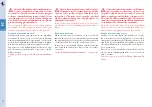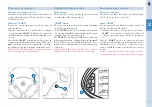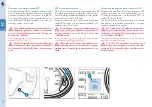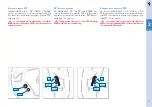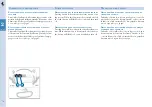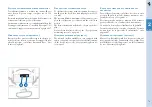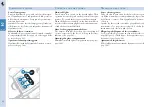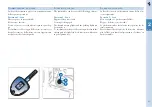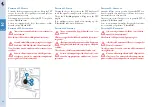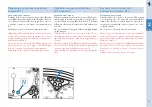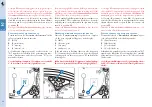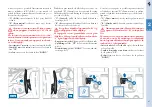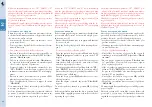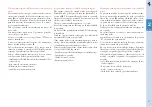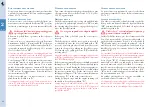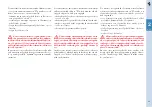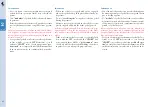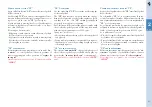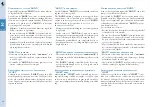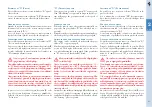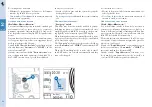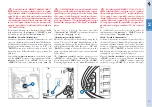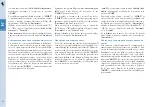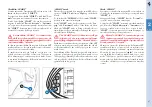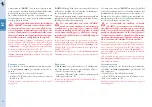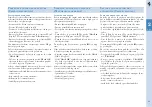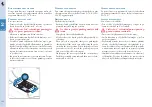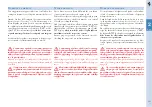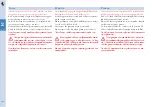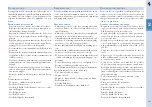
88
2
2.56
Riscaldamento del motore
Non portare il motore a regime di rotazione elevati fino
a quando la temperatura dell’olio non abbia raggiunto
almeno 65
÷
70
°
C circa.
Partenza della vettura
A motore avviato, veicolo fermo e pedale del freno pre-
muto, tirare verso il volante la leva destra
“UP”
per poter
inserire la
1ª
marcia oppure spostare in avanti la leva
D
.
Utilizzare la 1ª marcia per parcheggiare
e per le partenze in salita.
Rilasciare il pedale freno e premere sull’acceleratore
per partire.
Con motore acceso e vettura ferma è possibile passare
direttamente dalla
1ª
o
2ª
marcia alla
“R”
(retromar-
cia), azionando la leva
C
e dalla retromarcia alla
1ª
o
spingendo in avanti la leva
D
(vedi pag. 85) o tirando
verso il volante la leva
“UP”
.
L’inserimento della retromarcia è accompagnato da una
segnalazione acustica di sicurezza che suona ad intermit-
tenza per tutto il tempo in cui resta inserita la “
R
”.
Se nel passaggio
“R”
,
1ª,
il sistema inserisce automati-
camente la
2ª
marcia, ciò sta ad indicare che si è verifi-
cato un impuntamento sulla
1ª
marcia. Non si tratta
quindi di anomalia in quanto rientra nella logica di
funzionamento. Per lo stesso motivo nei passaggi da
1ª
,
“R”
nel caso di impuntamento il sistema inserisce
automaticamente la
“N”
.
Nelle soste prolungate, con motore in moto, è consi-
gliabile tenere il cambio in
“N”
.
Se, come può accadere in discesa, si lascia avanzare il vei-
colo in “
N
”, alla richiesta di “
UP
” verrà inserita una mar-
cia in relazione alla velocità del veicolo.
Warming up the engine
Do not run the engine at high speeds until the engine
oil temperature has reached at least 65
÷
70
°
C (149–
158
°
F), approximately.
Calentamiento del motor
No sitúe el motor en regímenes de giro elevados hasta
que la temperatura del aceite no alcance al menos unos
65
÷
70
°
C.
Salida del automóvil
Con el motor en marcha, vehículo detenido y pedal de
freno pisado, tire hacia el volante de la palanca derecha
“UP”
para introducir la
1ª
velocidad o desplace hacia
adelante la palanca
D
.
Utilice la 1ª velocidad para aparcar y
para arrancar en subida.
Suelte el pedal de freno y pise el acelerador para salir.
Con el motor encendido y el automóvil detenido, se
puede pasar directamente de la
1ª
o
2ª
velocidad a la
“R”
(marcha atrás), accionando la palanca
C
, y de la
marcha atrás a la
1ª
empujando hacia adelante la pa-
lanca
D
(véase pág. 85) o tirando hacia el volante de la
palanca
“UP”
.
Si se introduce la marcha atrás se conecta también una se-
ñal acústica de seguridad que suena intermitentemente todo
el tiempo que se encuentre engranada la marcha “
R
”.
Si en el paso
“R” 1ª,
, el sistema engrana automática-
mente la
2ª
velocidad, esto indica que se ha detectado
un entalonamiento en la
1ª
velocidad. No se trata por
tanto de una anomalía ya que se contempla en la lógica
de funcionamiento. Por lo mismo, en los pasos de
1ª
,
“R”
en caso de entalonamiento, el sistema sitúa el cam-
bio automáticamente en
“N”
.
En paradas prolongadas con el motor encendido, se
recomienda situar el cambio en
“N”
.
Si, como puede ocurrir en bajadas, se dejar avanzar el au-
tomóvil en “
N
”, al solicitar “
UP
” se engranará una veloci-
dad en relación con la velocidad que lleve el automóvil.
Driving the car
With the engine started, the car stopped and the brake
pedal pressed, pull the right-hand lever
“UP”
towards
the steering wheel in order to engage the
1st
gear or
move the lever
D
forward.
Use 1st gear to park or to depart uphill.
Release the brake pedal and press the accelerator to
start off.
With the engine on and the car stopped, it is possible
to shift directly from the
1st
or the
2nd
gear to
“R”
(reverse), by moving the lever
C
, and from the reverse
gear to the
1st
gear by pushing the lever
D
(see page
85) forward or by pulling the lever
“UP”
towards the
steering wheel.
Engagement of the reverse gear is accompanied by an acous-
tic safety signal that beeps intermittently for the entire time
that “
R
” remains engaged.
If the system automatically engages the
2nd
gear while
shifting from
“R “
to
1st
gear, it means that and inter-
ference has occurred during the
1st
gear engagement.
Therefore, this is not a malfunction, as it falls within
the system operation logic. For the same reason, when
shifting from
1st
gear to
“R”
, the system will automat-
ically engage
“N “
in the event of interference.
During prolonged stops with the engine running, it is
advisable to keep the gearshift in
“N “
.
As may happen on downhill stretches, if the vehicle is al-
lowed to travel forwards in “
N
“, when “
UP
“ is requested,
the system will engage a gear on the basis of the current
speed of the vehicle.
Содержание 612 scaglietti
Страница 1: ......
Страница 2: ...1 USO E MANUTENZIONE OWNER S MANUAL USO Y MANTENIMIENTO ...
Страница 23: ...2 2 1 6 7 8 9 10 5 4 3 2 12 11 1 13 1 16 Targhette Data plates Etiquetas ...
Страница 33: ...3 2 1 1 26 ...
Страница 152: ...151 2 7 8 9 5 1 2 3 3 3 3 3 3 4 4 1 1 2 1 6 2 119 Climatizzazione Airconditioningandheatingsystem Climatización ...
Страница 161: ...160 3 3 2 Gruppo motore Engine assembly Grupo motor ...
Страница 197: ...196 4 4 4 Cambio e differenziale Gearbox and differential Cambio y diferencial ...
Страница 207: ...206 4 6 3 13 2 5 4 7 4 7 8 8 1 12 6 9 4 9 4 11 10 4 14 ...
Страница 292: ......

